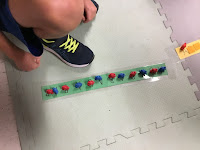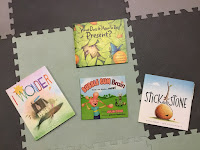Patterns and Community Building
Patterns and More
Patterns
We have begun our math unit sorting objects and making patterns. We are using toys and manipulative that we have in the classroom. The skills we have been practicing are: making a pattern, naming patterns and extending patterns. The students have strips of paper with the name of a pattern, their job is to replicate the pattern. After we practice several times, the children will create a pattern and write the name on a strip of paper.
We willl be looking at different ways to use objects to make patterns such as by the colour of the object, the shape, the size and the direction which the object faces.
Next week we will continue with patterns and play a game with pattern blocks and police cars. A child makes a pattern with a mistake in the pattern. A second child then drives the police car along the pattern until they find and correct the mistake.
We will continue with pattern practice through next week and then begin working on number sense.
Community Building
Stick and Stone
We have been enjoying many read aloud books about school and friendship. On Wednesday, we read the story Stick and Stone. This is a wonderful book that shares the story of an unlikely friendship between a stick and a stone. After we read the story the brainstormed all the types of playground equipment at school. The students were asked to work in groups to draw equipment that Stick could play on, that Stone could play on and what they could play together.
Once they had generated their ideas, on Friday they were given the task of building a playground for Stick and Stone to play on using toys in the class.
Working together, sharing materials, sharing ideas and deciding on how to build together is really tough work.
Growth Mindset
We are also reading books about growth mindset which have the message that it is okay to make mistakes. When we make mistakes we learn and stretch our brain. We have been talking about what it means to be present and practice mindfulness. We have been talking about the parts of our brain (prefrontal cortex, hippocampus and amygdala) and how each helps us at school. As well, we have been talking about our elastic brain and how we can stretch our brain to try new things that are hard or challenging. We have also been talking about the "power of "YET".
Our Emotions
We have been giving our emotions colours, not as a value or in judgement but as a way of differentiating which colours support learning and which colours are better for other situations and may make learning harder.
We have been talking about how all our feelings are valid and that there is a time and place for all of our feelings. When we have strong feelings at school, those feeling are valid. The children are being introduced to tools and techniques that help to manage big feelings. In class we have a selection of fidgets and a calm corner to support kids at school.
Our feelings
Blue (sad, tired, moving slowly) - For example. these are appropriate at bed time but not when you want to play tag or build a pattern in class.
Red (anger, yelling)- For example, it is appropriate to yell loudly when playing soccer and you want someone to pass the ball but not during quiet reading.
We also want to be cautious with these feelings, sometimes our actions can be unkind when we are in the red zone.
Yellow (wiggly, silly, frustrated)- For example, being silly is appropriate with family and friends or during a silly song but may not be appropriate during an assembly.
Green (calm, ready to learn, focused, feeling okay)- These are the ones that help us to learn and make good decisions during lessons and work time.
The colours I am using come from a program called "Zones of Regulation"
For parents
Things you can do at home:
- Let your child have unstructured time to play. At this point in the year, they are very tired and need play time to process all that has happened in the day.
- Ask your child about the bubble gum brain and the brick brain.
- Have your child use the pipe cleaner they brought home to show you how to identify the core (le coeur) of a pattern.
- Have crayons and art supplies on hand and encourage time to draw and colour. This helps to process their day and it supports writing. In the primary grade (through grade 3) we often start with a drawing to facilitate writing and generating ideas for writing.
- Count in French, especially higher than 30! There are links to videos that have the French counting words under the tab "Songs we are singing" at the top of the page.






